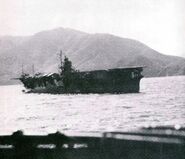Sōryū (Japanese: 蒼龍, lit. Blue (or Green) Dragon) was laid down on 20 November 1934 at Kure Naval Dockyard, her construction taking 13 months. She was launched in late December, 1935, and passing trial successfully she was commissioned in December, 1937. She was one of the first carriers to be built from the keep up as a carrier and established the basic format for all future Japanese carrier classes, not a converted battleship or battlecruiser; she incorporated lessons from the Ryujo and other carriers.[1]
Description[]
She was reminiscent of a cruiser, with a length-to-beam ratio of 10 to 1. Belt armor was 1.8" with an internal, anti-splinter bulkhead. She has about 1" of armor over her machinery and 2.2" of armor over fuel and magazines. Sōryū did not carry a bulge.
Her machinery resembled that of the Mogami-class CA, and consisted of four geared turbines that chugged out 150,000 shaft horse power. With a fuel capacity of 3,670 tons of oil, she had a maximum range of 7,750 nautical miles at 18 knots, or 21 mph. Her funnel sent any emissions out a pair of down-curving funnels that were located amidships, near the island. This allowed the flight deck to remain clear of smoke in most wind conditions.
Her sleek hull and hilariously powerful machinery allowed her to hit nigh on 35 knots, making Sōryū the fastest carrier in the world at the time she was commissioned.
The 712 foot long flight deck caused an overhang on both sides of the hangar but not over the bow or stern. It was supported outside the hangar box by steel girders. Her small island sat atop a sponson extending outside the hull and thus, did not affect flight operations. Nine electrically-operated arresting cables were installed, capable of stopping a 6.5 ton aircraft at speeds up to 78 knots.
To accommodate quick transfer of aircraft from hangar to deck and vice-versa, Sōryū was designed with three elevators in mind. The largest of these, located in the middle, along with the two outer, smaller ones (located just starboard of the centerline), was capable of carrying a 11,000 lb aircraft.
Sōryū contained two hangars, one atop the other, with the top hangar being roughly 520 feet long and the lower about 420 feet. Clearance was limited to 15 feet in the upper hangar and a measly 13.9 feet in the lower.
This caused maintenance issues, where in the upper a B5N's wings could not be spread and in the lower, the cowling of a "Zero" came within 4 feet of the ceiling.
Anti-aircraft armament was provided by 6x2 batteries of 5" DP guns, mounted below flight deck level with 3 set forward and 3 set aft. Each of these had their own Type 94 FCD, though a seventh could provide back-up fire in case of emergency, though at a reduced rate of fire.
Short-range AA armament consisted of fourteen double 25mm AA guns, located below flight deck once again. Three were located on a platform just below the forward end of the flight deck.
History[]
As the flagship of Carrier Division 2 Sōryū was active off China. During the opening stages of the Pacific War, she participated at the Pearl Harbor raid, commandeered by Captain Ryusaku Yanagimoto, and launched two waves of planes; her first wave attacked with armor piercing bombs, the second, torpedoes.
From 21 December to 23 December 1941 Sōryū launched air strikes against Wake Island. In January 1942 she supported the invasion of the Palau Islands and the Battle of Ambon. On 19 February 1942 Sōryū launched air strikes against Darwin, Australia. In March 1942 she took part in the Battle of the Java Sea, helping sink the US tanker Pecos.
In June of 1942, Sōryū was one of the four carriers contained in Vice Admiral Nagumo's 1st Carrier Striking Force during the battle of Midway. The fighter complement consisted of 21 A6M Zeros, with 21 D3A Vals and 21 B5N Kate as dive bombing and torpedo bombing support, respectively. On the 4th of June, she launched her first wave against the 'Murican base on Midway Atoll. At 10:25, whilst preparing a second wave to launch a strike against the enemy carrier group, she was swarmed by thirteen SBD Dauntless DBs from the Yorktown. Sōryū took three hits from 1,000 lb bombs. The first penetrated to the lower hangar deck, and the other two detonated in the upper hangar. Because the hangars contained armed and fueled craft, secondary explosions went off throughout the ship. Within a short time, the fires went out of control; at 10:40 she was stopped and her crew were picked up by the Isokaze and the Hamakaze. Sōryū sank at 7:13 PM. Losses were 711 crew out of 1103, including Captain Yanagimoto, who decided to go down with his ship. This was the single highest mortality rate of all the carriers at Midway, largely due to the uncontrollable fires in the hangars.[2] She sank as a result of scuttling by the Isokaze, 4 June 1942, at position 30°42' N 179°37' W.








